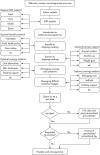A randomised control study of a fully automated internet based smoking cessation programme
- PMID: 16436397
- PMCID: PMC2563640
- DOI: 10.1136/tc.2003.006189
A randomised control study of a fully automated internet based smoking cessation programme
Abstract
Objective: The objective of this project was to test the short term (90 days) efficacy of an automated behavioural intervention for smoking cessation, the "1-2-3 Smokefree" programme, delivered via an internet website.
Design: Randomised control trial. Subjects surveyed at baseline, immediately post-intervention, and 90 days later.
Settings: The study and the intervention occurred entirely via the internet site. Subjects were recruited primarily via worksites, which referred potential subjects to the website.
Subjects: The 351 qualifying subjects were notified of the study via their worksite and required to have internet access. Additionally, subjects were required to be over 18 years of age, smoke cigarettes, and be interested in quitting smoking in the next 30 days. Eligible subjects were randomly assigned individually to treatment or control condition by computer algorithm.
Intervention: The intervention consisted of a video based internet site that presented current strategies for smoking cessation and motivational materials tailored to the user's race/ethnicity, sex, and age. Control subjects received nothing for 90 days and were then allowed access to the programme.
Main outcome measures: The primary outcome measure was abstinence from smoking at 90 day follow up.
Results: At follow up, the cessation rate at 90 days was 24.1% (n = 21) for the treatment group and 8.2% (n = 9) for the control group (p = 0.002). Using an intent-to-treat model, 12.3% (n = 21) of the treatment group were abstinent, compared to 5.0% (n = 9) in the control group (p = 0.015).
Conclusions: These evaluation results suggest that a smoking cessation programme, with at least short term efficacy, can be successfully delivered via the internet.
Conflict of interest statement
Competing interests: none declared
Similar articles
-
Happy ending: a randomized controlled trial of a digital multi-media smoking cessation intervention.Addiction. 2008 Mar;103(3):478-84; discussion 485-6. doi: 10.1111/j.1360-0443.2007.02119.x. Addiction. 2008. PMID: 18269367 Clinical Trial.
-
Population-level effects of automated smoking cessation help programs: a randomized controlled trial.Addiction. 2013 Mar;108(3):618-28. doi: 10.1111/j.1360-0443.2012.04091.x. Epub 2012 Nov 1. Addiction. 2013. PMID: 22994457 Clinical Trial.
-
Effect of tailoring in an internet-based intervention for smoking cessation: randomized controlled trial.J Med Internet Res. 2011 Dec 15;13(4):e121. doi: 10.2196/jmir.1605. J Med Internet Res. 2011. PMID: 22169631 Free PMC article. Clinical Trial.
-
Effectiveness of an internet-based worksite smoking cessation intervention at 12 months.J Occup Environ Med. 2007 Aug;49(8):821-8. doi: 10.1097/JOM.0b013e3180d09e6f. J Occup Environ Med. 2007. PMID: 17693778
-
[Diversity and accessibility of smoking cessation aids in the internet].Gesundheitswesen. 2008 Jun;70(6):372-6. doi: 10.1055/s-2008-1080934. Gesundheitswesen. 2008. PMID: 18661461 Review. German.
Cited by
-
A Christian Faith-Based Facebook Intervention for Smoking Cessation in Rural Communities (FAITH-CORE): Protocol for a Community Participatory Development Study.JMIR Res Protoc. 2023 Dec 13;12:e52398. doi: 10.2196/52398. JMIR Res Protoc. 2023. PMID: 38090799 Free PMC article.
-
The Impact of Smokers' Information-Seeking Behavior on Smoking Cessation.Adv Exp Med Biol. 2023;1425:645-662. doi: 10.1007/978-3-031-31986-0_63. Adv Exp Med Biol. 2023. PMID: 37581838
-
Using the Unified Theory of Acceptance and Use of Technology (UTAUT) and e-health literacy(e-HL) to investigate the tobacco control intentions and behaviors of non-smoking college students in China: a cross-sectional investigation.BMC Public Health. 2023 Apr 25;23(1):765. doi: 10.1186/s12889-023-15644-5. BMC Public Health. 2023. PMID: 37098499 Free PMC article.
-
Automated Digital Interventions and Smoking Cessation: Systematic Review and Meta-analysis Relating Efficiency to a Psychological Theory of Intervention Perspective.J Med Internet Res. 2022 Nov 16;24(11):e38206. doi: 10.2196/38206. J Med Internet Res. 2022. PMID: 36383408 Free PMC article. Review.
-
Internet-Based Intervention Compared to Brief Intervention for Smoking Cessation in Brazil: Pilot Study.JMIR Form Res. 2022 Nov 3;6(11):e30327. doi: 10.2196/30327. JMIR Form Res. 2022. PMID: 36326817 Free PMC article.
References
-
- Cassell M M, Jackson C, Cheuvront B. Health communication on the internet: an effective channel for health behavior change? J Health Commun 1998371–79. - PubMed
-
- Etter J F. Using new information technology to treat tobacco dependence. Respiration 2002697–11. - PubMed
-
- PriceWaterhouseCoopers HealthCast 2010: Healthcare on the internet. 2 November 1999. Retrieved 17 April 2003 from http// www.pwchealth.com/healthcast2010/html
Publication types
MeSH terms
Grants and funding
LinkOut - more resources
Full Text Sources
Medical

